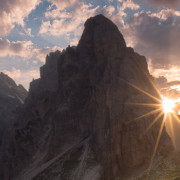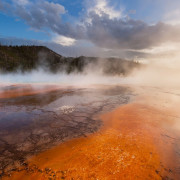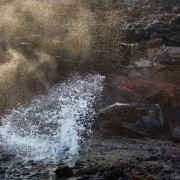Why Landscape Photographers Should Expose To The Right
Every so often, earnest letters from aspiring landscape photographers land in my inbox inquiring about the reasoning behind “expose to the right,” also referred to as ETTR. Do I practice it, and does it make any difference in the quality of my photographs?
Yes, I do. And, yes, it does.
First, the following article is likely to be the most technical one you will ever see from me. I frequently write about the creative aspects of landscape photography. However, it is important for landscape photographers to understand technical fundamentals as well. This is so you can get on with creating better and more artistically compelling images.
Now, what is ETTR, you may ask?
The term refers to the diagram of the histogram you can view on your camera’s LCD screen and in digital photo raw processing software. The histogram is an approximate visual representation of the exposure of an image. It looks like this.
Tonal distribution of any given image is graphically represented by its histogram. The dark tones are on the left side of the graph. The mid-tones are in the middle, and the highlights are on the right side. To “expose to the right” means to expose your image so that the lightest tones are pushed to the right side of the histogram. This is known as the highlight side, just to the point before clipping or blowing out the highlights occurs.
Clipping refers to loss of either highlights or shadows by either over- or under-exposing the image. A photo that is “clipped” will have data points touching the far left or far right of the histogram’s edge. That’s not what you want. The goal of ETTR is to expose the image so that the data points are pushed as far to the right as possible without actually touching the side of the binding box, and — for most images — away from the left edge. You can do this either by using the manual mode for exposing, or using exposure compensation.

The camera’s light meter exposed the histogram on the left. The photographer used ETTR to expose the histogram on the right.
In the left image above, the camera’s light meter exposed the photo to the left as shown by the histogram. The photographer used ETTR to set the exposure to the right as seen in by the histogram in the right image.
With practice, you can learn to read the histogram in photography properly. In addition, you can learn to control exposure without overexposing or underexposing the image, regardless of your camera’s light meter readings.
So, why should you consider using expose the right technique?

ETTR can help with shadow details in landscape photos – ISO 100, f/16, .3 sec., Canon 5DsR, 70-200mm f/2.8L lens
An landscape photo like this one is all about texture and detail. Expose to the right technique ensures detail in the shadow area, and if controlled properly, the retains the detail in the hot, yellow areas.
Tones in Highlights & Shadows
Tones are not recorded equally across the entire range of dark to light on digital sensors. When your digital camera records image data, the brightest part of the photograph (or highest stop) uses half of all the tonal values in the entire image. That is because a one-stop difference represents a doubling or halving of the camera exposure. Therefore, a doubling or halving the tonal values recorded. The next highest stop uses half again of the remaining values, the next uses half of what is left and so on, such that the lowest (or darkest) stop uses only a small fraction of the tonal values available, as shown in the diagram below.
It’s all about the details.
Cameras still cannot record as much dynamic range in a scene as the human eye can detect. And, furthermore, there are situations where the scene’s contrast range is lower than your camera’s sensor dynamic range. So, in order to maximize detail from your images, you need to ensure that your camera’s sensor is collecting as much information as possible. That is the driving force behind ETTR. ETTR is exposing the image as light as possible without clipping the highlight. The maximum amount of information and detail is retained by deliberately using ETTR as well as normalizing the camera exposure in post-processing.
For the type of work that I do, I want to ensure that all the fine detail of my photograph draws the viewer deeper into the image. That means I need to make sure I have properly exposed in the field using ETTR principles.
Is ETTR still relevant with the latest improvements in sensor technology?
Yes, because not everyone has the newest fancy camera. And, even if you do own the latest technology, it still may be a good idea to employ the principles of ETTR. Even today’s best sensors will only tolerate so much lifting of the shadows before noise becomes a problem. The caveat is that you must have enough knowledge of your specific camera, and the experience to control your exposure without blowing out the highlights.
The two images above are enlargements showing the shadow details of two different exposures, and then normalized in post-processing. The camera’s meter exposed the left image and was darker. The right image was ETTR. There is noticeably more noise and loss of tonal detail in the image on the left, which used the meter reading to expose.
When not to expose to the right.
- Low contrast scenes will not really benefit from ETTR if there are no dark shadow areas. A low contrast scene exposed to the right has the potential for visible sensor saturation artifacts (banding). Instead, a nice, mid-range histogram is what you want for these types of scenes.
- Avoid blowing out areas with smooth luminosity gradients, because this can also lead to banding.
- If you are an event photographer, it’s easy to clip highlights if you’re not careful because lighting and subject change so quickly, so be sure to keep a close eye on the histogram, and err on the side of underexposure.

High key image of Whooper Swans flying in a snow storm created a challenge to get the exposure right.
Watch for clipping in RGB channels.
Don’t forget to monitor the RGB channels for clipping as you adjust your exposure. Some cameras allow you to see all three channels — red, green, and blue — in a histogram. As a landscape photographer it is important to also look for clipping in these channels, which might not show up in the monochrome version of the histogram. The red channel is the most common color to clip in landscape photography. Blue is the next most common, but clipping can occur in any channel depending on your subject. When you see clipping in any one of the individual channels, then reduce the exposure until the clipping is eliminated.
When I made this above image, I carefully monitored the red channel to ensure I preserved the detail in the clouds. Fortunately, I had envisioned a dark, moody feel to this piece. So, I wasn’t particularly concerned about lifting detail in the shadows.
Experiment
Each camera sensor will handle noise in the shadows differently. If you want to understand how your specific camera handles dynamic range, conduct your own tests. Using your camera’s native ISO, bracket several exposures, then normalize the exposure of the bracketed images in a post-processing. Compare the details in the shadow areas, and look carefully at the tonal range across the entire image. How does the noise compare in the different exposures? What do you consider an acceptable amount of noise?
As you experiment, keep in mind that most cameras only offer an approximation of the actual histogram. Small highlights may fail to display properly on the camera’s LCD screen. In this case, monitoring the “blinkies” — over-exposure alert — is a good idea. Post-processing can recover some blown-out highlights after the fact, but not all. Much depends on the image and the camera. In post-processing, you will be able to examine the full dynamic range of the histogram using raw processing software such as Adobe Camera Raw, Adobe Lightroom, CaptureOne, or Adobe Photoshop.
This high-contrast image was difficult to make with just a single exposure, but since I didn’t care so much about detail in the forest areas, I prioritized the exposure for the clouds. The RAW photo was quite dark, but I was able to preserve all the beautiful detail in the sky and mountains.
Is ETTR the right approach for you?
As for your own practice, you will need to decide if it is worth it to go through the trouble to capture every bit of detail possible from your exposures. For example, if you typically post your images to Instagram, then the benefit of ETTR is likely to go unnoticed and unappreciated. But if you are like me and print your work, then you’ll be glad that you took the extra care to get the camera exposure right in the field so that all that rich detail is there in your print.
















Great article, but it seems that someone broke the links to your diagram images, and I’d love to see those. Any chance someone can reconnect them? I’ll happily come back to visit again to ingrain the lessons with visuals!
Thanks for the heads up, Leah. The links have been repaired. I hope you enjoy the article!
It’s nice to read a well written article about proper exposure technique. I’ve been “exposing to the right” since learning of the “obvious once you hear about it” concept from John Gerlach in 2009. I don’t bother with the composite histogram, but rather make sure that none of the channels (especially the red) are overexposed. Exposing is SO EASY with this wonderful tool. Great article, and great photos!
Thank you for this article. After decades of shooting film I find it difficult to do digital professional, as most of the agencies I shoot for ask for slides (mostly medium format) but will also accept digital. The real trick is knowing WHEN to use ETTR. Thank you for explaining how. Have fun in San Fran.
Nice article and nicely explained. I would like to acknowledge the person who first discussed this on the web in 2003, the late Michael Reichmann, a true pioneer in digital photography.
In the comparison of two images above (the ones with the mountain top and tree), you state that the image on the right was the ETTR, and the one on the left was as per the camera’s meter. However, the text in the images has the shutter speed at 1/13 s for the left image, and the right at 1/20 s. Given that the ISO and the aperture are the same, the image on the right actually received less light (shorter exposure) than the one on the left. So, it could not have been more “to the right”. It seems backwards.
You are correct…the label seem to be switched. Let me see if we can correct it.
Thanks for the article Charlotte. I’m always interested in people’s thoughts on this subject. I understand where you’re coming from when you recommend shooting to the right but I have a another point of view. I’ve learned that shooting to the left often leaves me with better chances of getting a shot in a scene with a large dynamic range because I can recover the lost shadows easier than if the lights are blown out. I understand shooting to the right if you have time to set up and analyze the histogram for one specific shot, that makes sense for sure. When I’m in a situation where the needed exposure is constantly changing would you agree that shooting to the left might be a better idea? I’m interested in your thoughts on this.
Thanks for your question, Sam! In Part Two of this article, I discuss a caveat to when NOT to expose to the right (ETTR). The goal is to make an exposure as light as possible WITHOUT blowing out the highlights. This can be difficult in certain situations, especially if you are a street or event photographer. In those cases, I agree it is better not to risk overexposing to the point where you cannot recover the highlights. In landscape photography, it makes sense to ETTR because, as you suggest, there is more time to set up and analyze the histogram. Some camera sensors are more forgiving than others when it comes to recovering shadow detail. My Sony a7RII lets me get away with darker exposures than my Canon 5DsR, for example. That why I suggest testing your specific camera for noise tolerance and then choose how you want to expose according to your own style and equipment limitations. Make sense?
Possibly the best and clearest explanation of ETTR I have ever read. In fact the best compliment I can give is that the article is “written to the right”. Thank you.
Gosh, thanks! Writing technical articles is always tricky because one can’t know how much the reader already understands about the topic. I’m glad you found the article helpful and I didn’t bore you to death!